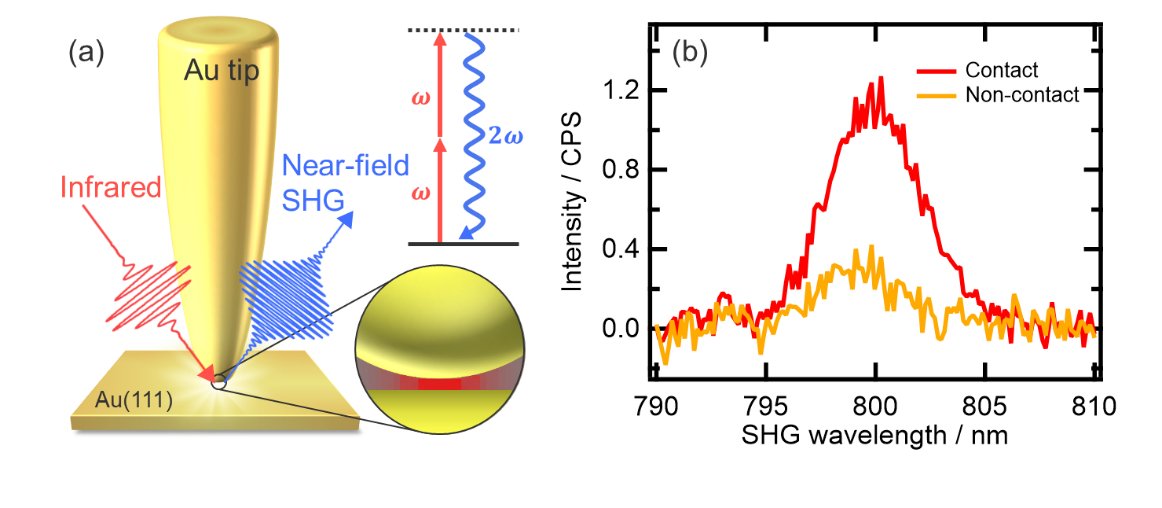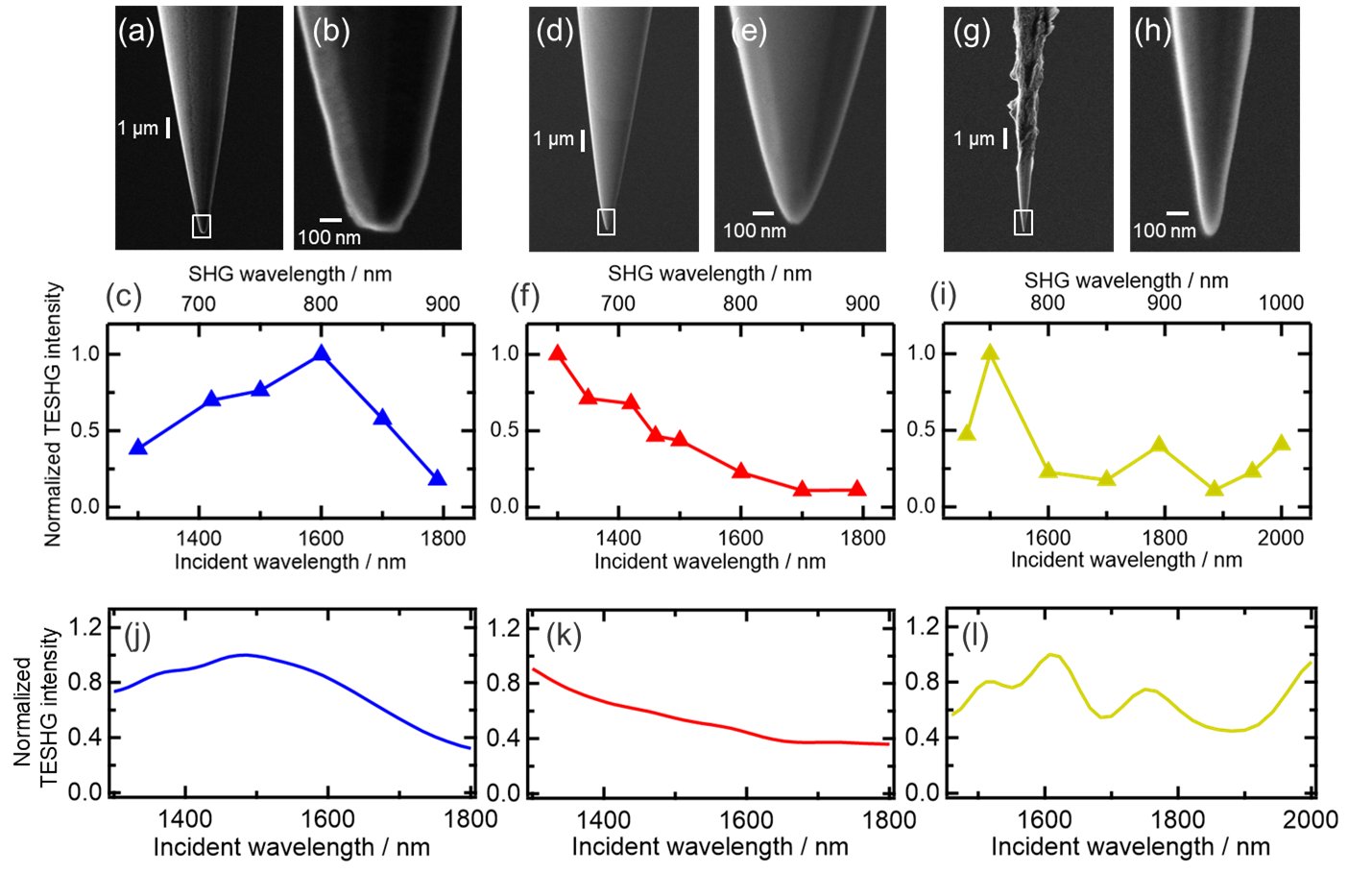Significantly broad nonlinear optical response was discovered to be enhanced in a tip-substrate plasmonic nanocavity. Focusing on the near-field second harmonics caused by a wavelength-tunable femtosecond laser, it was found that the tip-enhancement of nonlinear optical effects efficiently works over a broad wavelength range, spanning the visible to infrared regions. This broadband nonlinear optical property is directly affected not only by the nanometer-scale sharpness of tip apexes but also by the micrometer-scale surface geometry of tip shafts.
Squeezing light beyond the diffraction limit and controlling the optical processes caused by nano-confined light are central issues of nanophotonics. In particular, localized and enhanced light at the plasmonic nanogaps in scanning probe microscopes provides us with a unique platform for obtaining site-specific optical information at the molecular/atomic scale. Very recently, not only linear but also nonlinear optics have been applied to such tip-enhanced nanoscopy to gain higher sensitivity and spatial resolution. In this context, understanding the intrinsic nonlinear optical properties of plasmonic nanocavities is of growing importance in controlling nanosized nonlinear optics more precisely.
Researchers (Dr. Shota Takahashi et al.) led by Toshiki Sugimoto, Associate Professor at the Institute for Molecular Science, succeeded in elucidating the intrinsic nonlinear optical properties of tip-substrate plasmonic nanocavities. Combining a wavelength-tunable femtosecond pulse laser system with a scanning tunneling microscope and focusing on the tip-enhancement of second harmonic generation (SHG, Figure 1), they reported an unexpectedly broad tip-enhanced nonlinear optical response in a plasmonic nanocavity.

Figure 1:Tip-enhanced second harmonic generation
(a) Schematic representation of the experiment. Local SHG signal is enhanced by irradiating an infrared laser pulse into the plasmonic nanogap between the gold tip and the gold substrate. (b) SHG spectra obtained with (red) and without (orange) plasmonic nanogap, indicating that the SHG signal is enhanced only when the tip is brought closer due to the plasmonic enhancement effect unique to the tip-substrate nanocavity.
They demonstrated that the tip-enhancement of SHG is maintained over the visible to infrared wavelength range (Figure 2a-c). Moreover, the prominent geometrical effects of plasmonic tips dominating this broadband enhancement ability were also verified; the broadband nonlinear optical property of tip-substrate nanocavities is significantly influenced not only by the structures of nanosized tip apexes but also by micrometer size tip shafts (Figure 2d-i).

Figure 2: Geometrical effects of plasmonic tips
(Upper panel) Scanning electron micrographs of the tips used in the tip-enhanced SHG measurements. Zoomed-in views of the regions indicated by white squares in (a), (d), and (g) are shown in (b), (e), and (h), respectively. (Middle panel) The intensities of tip-enhanced SHG obtained for the corresponding tips. Structural differences in nanometer-scale tip apex and micrometer-scale tip shafts give rise to the variation in the spectral property of SHG enhancement. (Lower panel) The excitation wavelength dependence of the tip-enhanced SHG intensity calculated for the tips shown in the upper panel. The calculated results excellently capture the characteristics of the observed tip-enhanced SHG.
The origin of these geometrical effects was unveiled by precise numerical simulations of plasmonic fields inside tip-substrate nanocavities. They theoretically demonstrated that broadband tip-enhanced SHG properties can be significantly altered in response to nanometer- and micrometer-scale tip structures. The simulations incorporating this structural information excellently capture the experimentally observed behavior (Figure 2j-l). More detailed analysis of these simulated results revealed the origin of geometrical effects on tip-enhanced SHG; while the micrometer-scale tip shafts extend the spectral range of the field enhancement to the near- and mid-infrared regions, the nanometer-scale tip apexes mainly contribute to boosting visible/near-infrared light. This indicates that the micrometer-scale tip shafts and nanometer-scale tip apexes jointly enable the simultaneous enhancement of both mid/near-infrared excitation and visible/near-infrared radiation processes, respectively, realizing the strongly enhanced SHG over the visible to infrared broadband region.
This demonstration of the significant broadband enhancement ability of plasmonic nanogaps provides a new basis for intentional control of site-specific nonlinear optical phenomena that are fundamentally accompanied by drastic wavelength conversion. Moreover, the group’s findings pave the way for developing next-generation tip-enhanced nanoscopy by exploiting various nonlinear optical processes. Based on these new techniques, correlated chemical and topographic information will be successfully addressed with ultimate spatiotemporal resolution, promoting cutting-edge microscopic research in a variety of physical, chemical and biological processes occurring in heterogeneous environments.
Paper information
Authors: Shota Takahashi, Atsunori Sakurai, Tatsuto Mochizuki, and Toshiki Sugimoto
Journal Name: The Journal of Physical Chemistry Letters
Journal Title: “Broadband Tip-Enhanced Nonlinear Optical Response in a Plasmonic Nanocavity”
DOI: 10.1021/acs.jpclett.3c01343
Financial Support
JST-PRESTO, JPMJPR1907
JST-CREST, JPMJCR22L2
JSPS KAKENHI
Grant-in-Aid for Scientific Research (A), 19H00865 and 22H00296
Grant-in-Aid for Scientific Research (B), 23H01855
Grant-in-Aid for Research Activity Start-up, 19K23640
Grant-in-Aid for Early-Career Scientists, 20K15236
Grant-in-Aid for JSPS Fellow, 22J01438
ATLA Innovative Science and Technology Initiative for Security, JPJ004596
CASIO SCIENCE PROMOTION FOUNDATION, 38-06
Research Foundation for Opto-Science and Technology
Contact Person
Name: Toshiki Sugimoto
TEL: +81-564-55-7280
E-mail: toshiki-sugimoto_at_ims.ac.jp (Please replace the "_at_" with @)
3971


